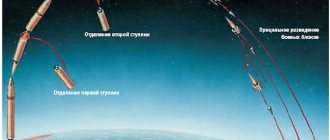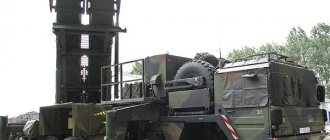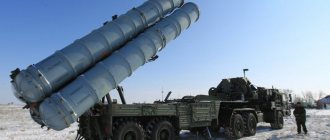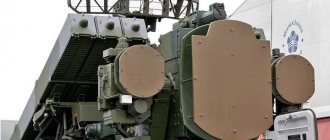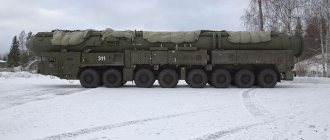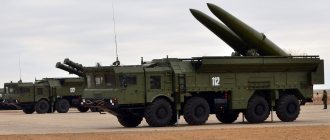Combat railway missile system "Molodets"
BZHRK - combat railway missile system RT-23 UTTH "Molodets" (according to NATO classification SS-24 Scalpel).
According to experts, this is the most formidable weapon that has ever existed on earth. It was created by teams led by brothers Academician of the Russian Academy of Sciences Vladimir Fedorovich Utkin and Academician of the Russian Academy of Sciences Alexey Fedorovich Utkin.
History of creation.
The very idea of creating such a project was unprecedented.
The order “On the creation of a mobile combat railway missile system (BZHRK) with the RT-23 missile” was signed on January 13, 1969. The Yuzhnoye design bureau was appointed as the lead developer. Here’s what Vladimir Fedorovich Utkin said about this: “The task that the Soviet government set before us was striking in its enormity. In domestic and world practice, no one has ever encountered so many problems. We had to place an intercontinental ballistic missile in a railway car, but the missile with its launcher weighs more than 150 tons. How to do it? After all, a train with such a huge load must travel along the national tracks of the Ministry of Railways. How to transport a strategic missile with a nuclear warhead in general, how to ensure absolute safety on the way, because we were given an estimated train speed of up to 120 km/h. Will the bridges hold up, will the track and the launch itself not collapse, how can the load be transferred to the railway track when the rocket is launched, will the train stand on the rails during the launch, how can the rocket be raised to a vertical position as quickly as possible after the train stops?” To create such a complex, a colossal number of new solutions were required. One of the most important problems was the weight of the rocket and launcher; a rocket with a TPK should weigh no more than 130 tons, otherwise the railway track will not hold up, which means new materials are needed; a rocket cannot be longer than an ordinary refrigerator car, but the design bureau did not create such short ones. Then it was decided to remove the nozzles into the engines themselves, although the world practice of rocket science did not know such solutions. The head fairing protrudes from the other end of the car, it is impossible without it - there will be no accuracy, at first they made it inflatable, but, according to calculations, it could not overcome the barrier of nuclear explosions of the missile defense, and then a metal folding fairing was designed! To prevent the fiery tail of the rocket from burning everything in the area, a powder engine was used, which pushes the rocket to a small height. Next, the rocket's maneuver engine was turned on, and the gas jet of the rocket's propulsion engine passes past the cars, container and railway track. Flight tests of the RT-23UTTH (15Zh61) missile were carried out from February 27, 1985 to December 22, 1987 at NIIP-53 (Mirny), a total of 32 launches were made. 18 trains were carried out for endurance and transport tests, during which more than 400 thousand kilometers were covered on the country's railways. Tests were carried out in various climatic zones from Salekhard in the north to Chardzhou in the south, from Cherepovets in the west to Chita in the east.
The first missile regiment with the RT-23UTTH missile went on combat duty on October 20, 1987 (Kostroma, commander V.Yu. Spiridonov). The last missile system was withdrawn from service in 2005.
Composition of the complex
The BZHRK includes a standard train configuration for the complex:
- three three-car launch modules with RT-23UTTH ICBMs;
- command module consisting of 7 cars;
- tank car with reserves of fuels and lubricants;
- three diesel locomotives DM-62.
A command module, which features increased protection against powerful electromagnetic radiation from the contact network. Unique special communications antennas have been developed for it, which are guaranteed to ensure the reception of combat control signals through the radio-transparent roofs of the cars. There was no way to take them outside, since the BZHRK should be in every way like an ordinary train.
Characteristics of the complex
- Firing range, km 10100
- Firing accuracy (maximum deviation), km 0.2-0.5
- Starting weight, t 104.50
- Flight reliability 0.98
- Rocket energy-weight perfection coefficient Gpg/Go, kgf/tf 31
- Rocket length, m - total 23.3 - without warhead 19.0 - in TPK 22.6
- Payload weight, kg 4050
Launcher
- Dimensions, m: - length 23.6 - width 3.2 - height 5.0
- Travel speed, km/h 80
- BZHRK resistance to shock waves, kg/cm2 - in the longitudinal direction 0.3 - in the transverse direction 0.2
When moving along the country's railway network, the BZHRK made it possible to quickly change the location of the starting position up to 1000 kilometers per day.
Rocket trains have become a constant headache for Americans. The Pentagon spent more money tracking them than the Utkin brothers spent creating them. Twelve reconnaissance satellites searched for them throughout our country, and even from space they could not distinguish these ghost trains from ordinary refrigerators.
Last place of deployment.
Unenviable fate
In the early 90s, our potential opponents almost turned into friends, although also potential ones.
We blew up mines, cut down rockets. The Americans hastily allocated money to destroy the hated missiles and even provided the latest cutting devices. To dispose of “rocket trains”, a special “cutting” line was installed at the Bryansk repair plant of the Strategic Missile Forces. In 2003-2005, all BZHRK complexes were removed from combat duty. The plant in Pavlograd (Ukraine) now makes trolleybuses instead of rockets. And Ukraine, having become a nuclear-free state, under the terms of the agreement cannot have, produce or maintain nuclear weapons. But there are still hopes for the return to operation of such a miracle of engineering. On September 5, 2009, Deputy Commander of the Strategic Missile Forces, Lieutenant General Vladimir Gagarin, said that the Strategic Missile Forces do not exclude the possibility of resuming combat railway missile systems
ps Today one of the BZHRK (without missiles) is at its “last refuge” in the exhibition of the Central Museum of the Oktyabrskaya Railway. at the Varshavsky railway station in St. Petersburg.
Advantages and disadvantages
The official reasons for removing the BZHRK from service were the outdated design, the high cost of recreating the production of the complexes in Russia, and the preference for mobile units based on tractors. The START-2 Treaty provided for the removal of the BZHRK from duty[22].
The Soviet BZHRK with the RT-23 UTTH missile also had the following disadvantages:
- The impossibility of completely camouflaging the train due to the unusual configuration (in particular, three diesel locomotives), which made it possible to determine the location of the complex using modern satellite reconnaissance tools. Nevertheless, for a long time the Americans could not detect the complex with satellites, and there were cases when even experienced railway workers could not distinguish the train from 50 meters[8].
- Lower security of the complex (unlike, for example, silo launchers), which can be overturned or destroyed by a nuclear explosion in the surrounding area. To assess the impact of the air shock wave of a nuclear explosion[23], a large-scale experiment “Shift” was planned[24] for the second half of 1990 - simulating a close nuclear explosion by detonating 1000 tons of TNT[23] (several train echelons of TM-57 anti-tank mines (100 thousand pieces)[25], taken from the warehouses of the Group of Soviet Forces in Germany, laid out in the form of a truncated pyramid 20 meters high[24]). The “Shift” experiment was carried out at 53 NIIP MO (Plesetsk) on February 27, 1991, when as a result of the explosion a crater with a diameter of 80 and a depth of 10 m was formed, the level of acoustic pressure in the habitable compartments of the BZHRK reached the pain threshold - 150 dB, and the BZHRK launcher was removed from readiness, however, after carrying out regimes to bring it to the required degree of readiness, the launcher was able to conduct a “dry launch” (imitation of a launch using a rocket’s electrical layout)[23]. That is, the command post, launcher and missile equipment remained operational.[24]
Supporters of the use of BZHRK, including the engineer of the launch team at the first tests of the BZHRK, the head of the group of military representatives of the USSR Ministry of Defense at the Yuzhmash Production Association, Sergei Ganusov, note the unique combat characteristics of the products, which confidently penetrated missile defense zones. The launch platform, as confirmed by flight tests, delivered warheads with a solid or total mass of 4 tons to a distance of 11,000 km. One product containing 10 warheads with a capacity of 550 kT each was enough to hit an entire European state.[8] The press also noted the high mobility of trains capable of moving along the country's railway network (which made it possible to quickly change the location of the starting position over 1000 kilometers per day), in contrast to tractors operating in a relatively small radius around the base (tens of km).[7]
Notes
- Combat railway missile system (Russian) (inaccessible link). Encyclopedia
. Of. website of the Russian Ministry of Defense. Retrieved October 28, 2012. Archived November 5, 2012. - LGM-30A/B Minuteman I - United States Nuclear Forces
- https://www.siloworld.net/DOWNLOADS/Mighty%20Ninety%20Reduced.pdf
- The Deseret News - Google News Archive Search
- The Deseret News - Google News Archive Search
- ↑ 1234
BZHRK arrives on schedule // zdr.gudok.ru - ↑ 1234
“Well done” was hiding on a strategic train // gudok.ru - ↑ 123
The rocket we made Archived copy from March 19, 2013 on the Wayback Machine // Pavlograd News - Alexander Dolinin.
And what was “Well done”... Journalists from “Red Star” conducted a “rocket train”
(unspecified)
. "Red Star" (August 30, 2005). Access date: January 9, 2011. - Glotin D.P. et al.
Reliable shield of the Fatherland. Strategic Missile Forces on Perm land / Ed. A. S. Korolev and M. A. Druzhinina. - Perm: Publishing House "Mamatov", 2009. - P. 50-51. — ISBN 978-5-91076-28-2. - The Strategic Missile Forces do not rule out the possibility of using BZHRK (Russian). ITAR-TASS (September 7, 2009). Access date: September 18, 2009.
- In Russia, the reconstruction of railway missile systems has begun (unspecified)
. Retrieved April 23, 2013. Archived April 28, 2013. - Russia is recreating combat railway missile systems (unspecified)
. Retrieved April 23, 2013. Archived April 28, 2013. - Combat railway missile systems will again appear in Russia (unspecified)
. Access date: April 23, 2013. - Russia's new railway missile system will be armed with a Yars-type missile // Gazeta.Ru
- In response to the US global strike program, Russia is creating a railway missile system // Gazeta.Ru
- Will Russia have time to create a BZHRK before the US strike? (undefined)
. Vesti (December 17, 2014). - Russia has begun to create elements of a rocket train (Russian). TASS (May 12, 2016).
- The development of new generation combat railway systems has been stopped, Rossiyskaya Gazeta
(December 2, 2017). Retrieved December 2, 2022. - North Korea launched ballistic missiles from a train
- Bogdan LISOVOY.
BZHRK - a mistake of the past or present?
(unspecified)
(inaccessible link). Newspaper "Student Pravda". Access date: September 18, 2009. Archived August 25, 2009. - ↑ 123
Northern Cosmodrome of Russia / Under the general editorship. A. A. Bashlakova. - Mirny: Plesetsk cosmodrome, 2007. - T. 1. - P. 498. - ↑ 123
Northern Cosmodrome of Russia / Under the general editorship. A. A. Bashlakova. - Mirny: Plesetsk cosmodrome, 2007. - T. 1. - P. 99-103. - Northern Cosmodrome of Russia / Under the general editorship. A. A. Bashlakova. - Mirny: Plesetsk cosmodrome, 2007. - T. 1. - P. 120.
Links
- Media files on Wikimedia Commons
- BZHRK - Combat Railway Missile Complex on YouTube
- BZHRK RT-23 UTTH “Well done”
- Combat railway missile system 15P961 “Molodets” with ICBM 15Zh61 (RT-23 UTTH)
- This year has brought sensational news: the “branded” weapon of Russian rocket scientists - combat railway missile systems (BZHRK) remain in the combat composition of the Strategic Missile Forces // Popular Mechanics No. 4, 2003
- The railway missile system arrived at the terminal // RIA Novosti, 02/28/2008
- How the Americans derailed the Russian “nuclear train” // NG, 03/13/2009
- Photos of the abandoned base
- BZHRK: history and prospects (discussion on the rusarmy.com forum)
- d/f “Scalpel. Impact Tool: Ghost Train on YouTube (2011)
In literature
- The complex is described in the fantastic post-apocalyptic novel by V. Berezin “Way Signs” from the Metro Universe 2033 series. At the Warsaw Station, the main characters find a mothballed “Scalpel” and set off from St. Petersburg to Moscow.
- The novel “Atomic Train” by D. Koretsky describes a fictional modern BZHRK.
- In Dale Brown's novel Plan of Attack, Russia, in violation of the START treaties, restores missile trains, which become one of the main targets for the Americans after a Russian strategic air strike on the United States. It is alleged that the USSR had 150 BZHRK with three missiles each, and that the RT-23 UTTH missile was a copy of the American Peacemaker BZHRK missiles.
